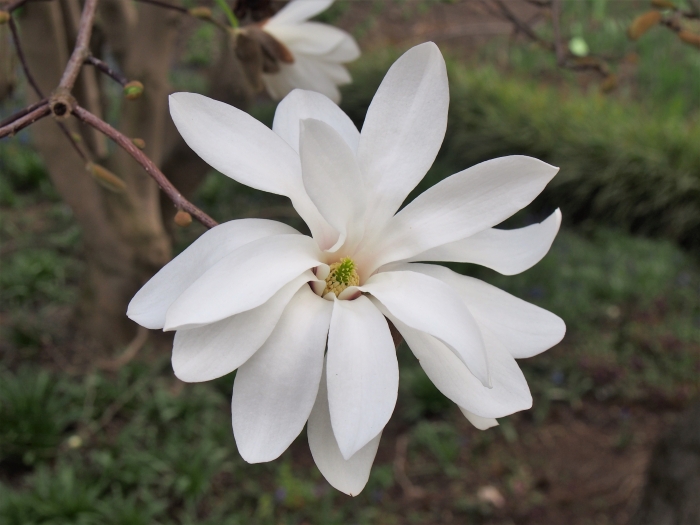Star Magnolia
(Magnolia stellata)
Star Magnolia (Magnolia stellata)
/
/

Agnieszka Kwiecień, Nova
CC BY-SA 4.0
Image By:
Agnieszka Kwiecień, Nova
Recorded By:
Copyright:
CC BY-SA 4.0
Copyright Notice:
Photo by: Agnieszka Kwiecień, Nova | License Type: CC BY-SA 4.0 | License URL: https://creativecommons.org/licenses/by-sa/4.0 | Uploader: Nova | Publisher: Wikimedia Commons | Title: Magnolia_stellata_Magnolia_gwiaździsta_2019-04-06_02.jpg | Notes: == Summary == {{Information |Description ={{en|1=Itea virginica 'Henry Garnet', photo taken in Belgium}} |Source ={{own}} |Author =[[User:Wouterhagens|Wouter Hagens]] |Date =2011-06-10 |Permission = |other_versions = }} [ |




























Estimated Native Range
Summary
Magnolia stellata, commonly known as Star Magnolia, is a slow-growing deciduous shrub or small tree native to the temperate regions of Japan, particularly found in areas around streams and pond margins. It typically reaches 1.5 to 2.5 meters (5 to 8 ft) in height and spreads up to 4.6 meters (15 ft) in width, with an upright oval growth in its youth that gradually spreads and mounds with age. The Star Magnolia is renowned for its large, showy white or pink flowers that bloom in early spring before the leaves unfurl, creating a striking display on bare stems. These blooms can be susceptible to damage from late spring frosts.
The Star Magnolia is valued for its compact size, making it suitable for smaller gardens, and its early spring blossoms that provide a welcome splash of color. It is often used in residential landscapes, as a specimen plant, or in border plantings. This species prefers deep, acidic, well-drained soil and thrives in full sun to part shade. It requires medium amounts of water and benefits from protection against late frosts. Propagation is possible through seeds or more effectively by rooting cuttings taken after the flower buds have formed. While generally low-maintenance, it can be affected by pests such as scale insects and diseases like leaf spot.CC BY-SA 4.0
The Star Magnolia is valued for its compact size, making it suitable for smaller gardens, and its early spring blossoms that provide a welcome splash of color. It is often used in residential landscapes, as a specimen plant, or in border plantings. This species prefers deep, acidic, well-drained soil and thrives in full sun to part shade. It requires medium amounts of water and benefits from protection against late frosts. Propagation is possible through seeds or more effectively by rooting cuttings taken after the flower buds have formed. While generally low-maintenance, it can be affected by pests such as scale insects and diseases like leaf spot.CC BY-SA 4.0
Plant Description
- Plant Type: Tree
- Height: 15-20 feet
- Width: 10-15 feet
- Growth Rate: Moderate
- Flower Color: White, Pink
- Flowering Season: Spring
- Leaf Retention: Deciduous
Growth Requirements
- Sun: Full Sun, Part Shade
- Water: Medium
- Drainage: Medium
Common Uses
Bee Garden, Bird Garden, Border Plant, Butterfly Garden, Deer Resistant, Fragrant, Rabbit Resistant, Showy Flowers, Street Planting
Natural Habitat
Temperate regions of Japan, particularly around streams and pond margins
Other Names
Common Names: Stern-Magnolie, Magnolia Étoilé, Stjärnmagnolia, Shide-Kobushi
Scientific Names: , Magnolia stellata, Magnolia kobus var. stellata, Magnolia kobus f. stellata, Magnolia rosea, Yulania stellata, Magnolia stellata var. rosea, Buergeria stellata, Talauma stellata, Magnolia stellata var. keiskei
GBIF Accepted Name: Magnolia stellata (Siebold & Zucc.) Maxim.